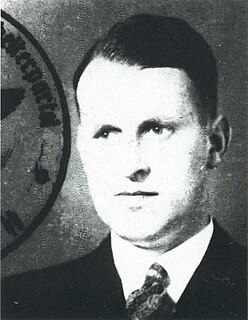
Hans Kammler was an SS-Obergruppenführer responsible for Nazi civil engineering projects and its top secret weapons programmes. He oversaw the construction of various Nazi concentration camps before being put in charge of the V-2 rocket and jet programmes towards the end of World War II. Kammler disappeared in May 1945, during the final days of the war. There has been much conjecture regarding his fate.
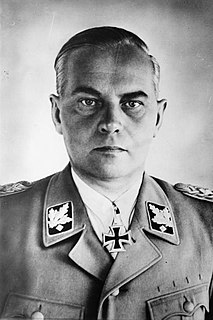
Felix Martin Julius Steiner was a German SS commander during the Nazi era. During World War II, he served in the Waffen-SS, the combat branch of the SS, and commanded several SS divisions and corps. He was awarded the Knight's Cross of the Iron Cross with Oak Leaves and Swords. Together with Paul Hausser, he contributed significantly to the development and transformation of the Waffen-SS into a combat force made up of volunteers and conscripts from both occupied and un-occupied lands.

Jonastal, situated in the Ilm-Kreis district in Germany between Crawinkel and Arnstadt and near to the town of Ohrdruf, was a scene of military construction under the National Socialist regime during the last years of the Second World War. Thousands of prisoners from the Buchenwald concentration camp under the command of SS General Hans Kammler were forced to dig 25 tunnels into the surrounding mountain and the whole operation was performed under the strictest secrecy. The site was not completed and construction was abandoned before the end of the war.

Hitlers Bombe is a nonfiction book by the German historian Rainer Karlsch published in March 2005, which claims to have evidence concerning the development and testing of a possible "nuclear weapon" by Nazi Germany in 1945. The "weapon" in question is not alleged to be a standard nuclear weapon powered by nuclear fission, but something closer to either a radiological weapon or a hybrid-nuclear fusion weapon. Its new evidence is concerned primarily with the parts of the German nuclear energy project under Kurt Diebner.
Henry Ashby Turner, Jr. was an American historian of Germany who was a professor at Yale University for over forty years. He is best known for his book German Big Business and the Rise of Hitler (1985) in which he challenged the common theory that industrialists in Germany were the Nazi Party’s most influential supporters.
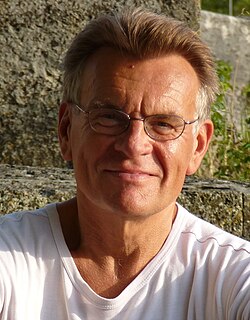
Lothar Machtan is a German historian, writer, as well as professor of Modern and Current History at the University of Bremen.
Erich Schumann was a German physicist who specialized in acoustics and explosives, and had a penchant for music. He was a general officer in the army and a professor at the University of Berlin and the Technical University of Berlin. When Adolf Hitler came to power he joined the Nazi Party. During World War II, his positions in the Army Ordnance Office and the Army High Command made him one of the most powerful and influential physicists in Germany. He ran the German nuclear energy program from 1939 to 1942, when the army relinquished control to the Reich Research Council. His role in the project was obfuscated after the war by the German physics community's defense of its conduct during the war. The publication of his book on the military's role in the project was not allowed by the British occupation authorities. He was director of the Helmholtz Institute of Sound Psychology and Medical Acoustics.
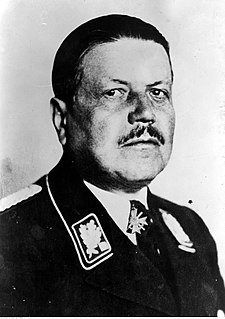
This article is based on a translation of the corresponding article in the German Wikipedia.
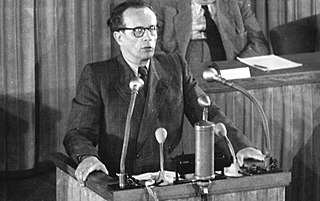
Vincenz Müller was a military officer and general who served in the German army, the Army of Nazi Germany, and after the war in the National People's Army of the (East) German Democratic Republic, where he was also a politician. Müller eventually became a member of the East German parliament, the Volkskammer, and served as chief of staff of the National People's Army.
Erich Kern, was a far-right Austrian journalist, war-time propagandist, and a post-war Nazi activist. He became a writer of revisionist books that sought to glorify the activities of the German soldiers during the Second World War.
Luigi Romersa was an Italian journalist and writer who worked as a war correspondent during the Second World War. He probably was the only Italian to enter USA Army missile bases during the Cold War. He was a friend of Wernher von Braun. He was best known for his essays about World War II. He was married to Mary Kisselov.
Ilko-Sascha Kowalczuk is a German historian and author. His work is focused on the German Democratic Republic and its Ministry for State Security.
Georg Wildführ was an East German Medical microbiologist and Hygienist.
Hans Mottek was one of the most important economic historians of the DDR.
Gerd R. Ueberschär is a German military historian who specialises in the history of Nazi Germany and World War II. He is one of the leading contributors to the series Germany and the Second World War and, together with Rolf-Dieter Müller, is the author of Hitler's War in the East 1941−1945: A Critical Assessment. Both works have been published in English translations.
Jörg Echternkamp is a German military historian, who specialises in the history of Nazi Germany and World War II. He is a lecturer in modern history at the Martin Luther University of Halle-Wittenberg and a research director at the Center for Military History and Social Sciences of the German Army (formerly the Military History Research Office. His is a contributor and editor of the seminal series Germany and the Second World War from the MGFA.
Sven Felix Kellerhoff is a German historian, journalist and author who specialises in the history of the Nazi era.
Hanns Christian Löhr is a German historian.
Michael Buddrus is a German historian.
Norbert Frei is a German historian. He holds the Chair of Modern and Contemporary History at the University of Jena, Germany, and leads the Jena Center of 20th Century History. Frei's research work investigates how German society came to terms with Nazism and the Third Reich in the aftermath of World War II.






